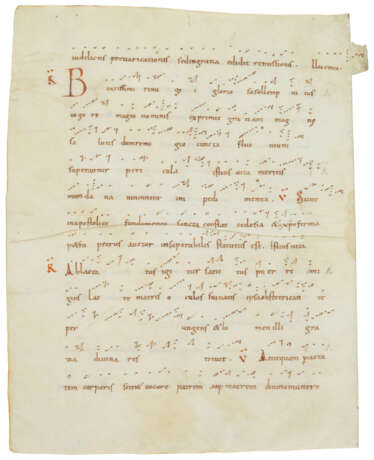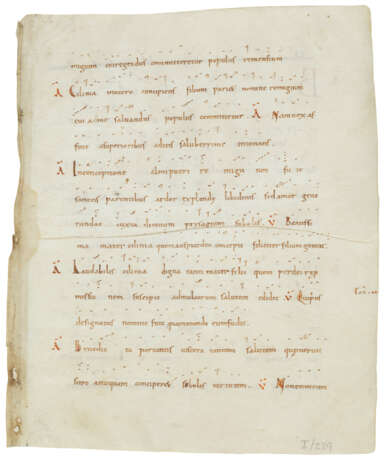ID 1053115
Lot 1 | Messine neumes
Valeur estimée
£ 40 000 – 60 000
A leaf from the liturgical Office of St Remigius, in Latin, manuscript on vellum [France, c.900]
The earliest notated office of St Rémy, among the earliest extant survivals of French Messine notation, a missing leaf from Vercelli, Biblioteca Capitolare Eusebiana, Cod. CCV.
c.180 x 150mm, 13 lines written in brown ink in a small Carolingian minuscule, ruled space: c.130 x 100mm, with clear non-diastematic Messine neumes, initials and rubrics in red (some marginal staining, generally in exceptional condition). Bound in grey buckram at the Quaritch bindery.
Provenance:
(1) The parent manuscript is Vercelli, Biblioteca Capitolare Eusebiana, Cod. CCV, an important hagiographical codex datable to the turn of the 10th century made up of autonomous sections and containing the Office of St Remigius (Rémy). The manuscript was likely produced in Reims for the Abbey of Saint-Rémy (on this see J. Hourlier, 'Extension du culte de s. Rémi en Italie', Études Grégoriennes, I (1954), pp.181-185; J-F. Goudesenne, 'La Musique de l'ancien office de s. Rémi retrouvée [IXe siècle]), Clovis, Histoire et mémoire, 1997, II, pp.103-28, suggests an origin at the Abbey on the basis of comparison with a series of responsories in Reims, Bibliothèque Municipale 316), which was founded by the Saint and served as his final resting place in 533. The present leaf was f.136, part of a discreet libellus at the end of the codex which was photographed by the monks of Solesmes in 1904 (Atelier de Paléographie, 118i), but was subsequently dispersed (subsequent publications referred to the 1904 photographs). On the fate of this libellus and the identification of two sister leaves at Harvard University, Houghton Library, MS Typ 704 (8) and MS Lat. 360 (2), ff.137-8 immediately following the present leaf, see T. F. Kelly, 'The Earliest Notated Office of Saint Remigius Lost and Found', Études Grégoriennes, XLII (2015), pp.91-98. On the Harvard leaves, see Kelly's entry in Beyond Words: Illuminated Manuscripts in Boston Collections, 2016, pp.80-1, nos 53-4, in which he raises the possibility of this having been a separate libellus of music.
(2) Bernard Rosenthal, his 'I/239'.
(3) Bernard Quaritch, Bookhands III, cat. 1088 (1988), no 31.
(4) Schøyen Collection, MS 96.
Text:
The text of the fragment is from the Office of Saint Remigius, a cycle of chants for the celebration of the Saint's feast day on 1 October, beginning '[Re]migium cui regendus committeretur populus Remensium' and ending 'vocare patrem atque matrem divino munere [virtutes operatus est]' (see J-F. Goudesenne, Les offices historiques ou Historiae composés pour les fêtes des saints dans la province ecclésiastique de Reims (775-1030), 2002, I, pp.75-80). According to T. F. Kelly, the present leaf and the two Harvard leaves 'comprise almost all the liturgical music required for a full office. The consecutive leaf of the Schøyen fragment might have included music for vespers to conclude the liturgical day' (Beyond Words, p.80). The texts present here are based on hagiographies of St Rémy by Hincmar of Reims (806-882) and Pseudo-Fortunatus (Bibliotheca hagiographica latina 1898-1901, 1:7152). This source is therefore almost contemporary with the composition of the Office.
Script and Music:
David Ganz and Susan Rankin have suggested a date in the first half of the 10th century (T. F. Kelly, 'The Earliest Notated Office of St Remigius', p.92, note 11), but it is possibly datable to the late 9th (see Bookhands III, no 31). The script bears many similar features to the hands at work in Paris, Bibliothèque nationale de France, Latin 1597A, another manuscript from the turn of the 10th century (c.875-900), made for the Abbey of Saint-Rémy: we see the same light clubbing to the tall, vertical main strokes, the same open-bowl 'g' (present in two of the hands in the BnF manuscript), and 't' without ascender but as 'tau'. The notation is non-diastematic Messine neumes, in use at Reims and elsewhere, without line, clef or custos (a mark at the end of the line serving a cue for the music on the following staff). 'It is among the earliest witnesses of this style of notation' (Beyond Words, p.81). Music this early almost never appears on the market.
| Lieu d'origine: | France |
|---|---|
| Catégorie maison de vente aux enchères: | Manuscrits médiévaux et de la Renaissance |
| Lieu d'origine: | France |
|---|---|
| Catégorie maison de vente aux enchères: | Manuscrits médiévaux et de la Renaissance |
| Adresse de l'enchère |
CHRISTIE'S 8 King Street, St. James's SW1Y 6QT London Royaume-Uni | ||||||
|---|---|---|---|---|---|---|---|
| Aperçu |
| ||||||
| Téléphone | +44 (0)20 7839 9060 | ||||||
| Commission | see on Website | ||||||
| Conditions d'utilisation | Conditions d'utilisation |




